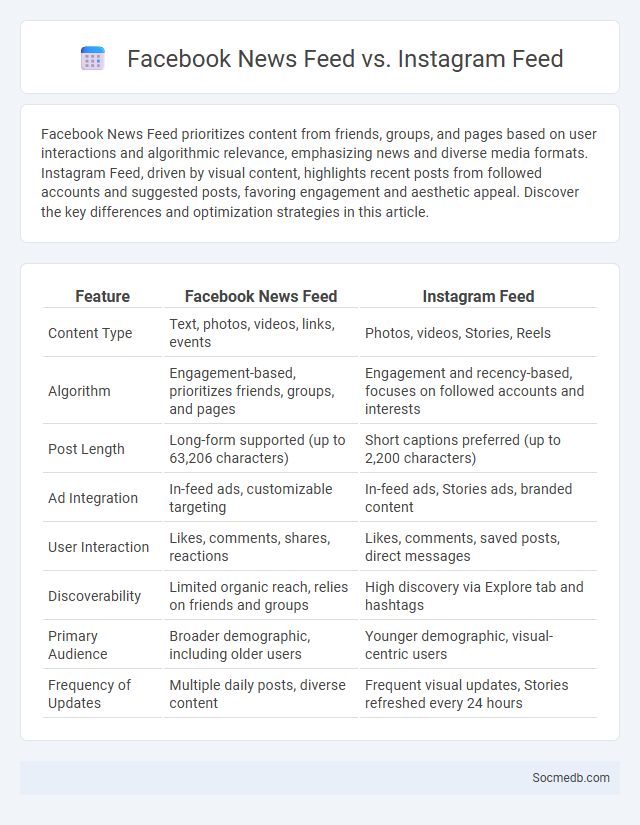
Photo illustration: Facebook News Feed vs Instagram Feed
Facebook News Feed prioritizes content from friends, groups, and pages based on user interactions and algorithmic relevance, emphasizing news and diverse media formats. Instagram Feed, driven by visual content, highlights recent posts from followed accounts and suggested posts, favoring engagement and aesthetic appeal. Discover the key differences and optimization strategies in this article.
Table of Comparison
| Feature | Facebook News Feed | Instagram Feed |
|---|---|---|
| Content Type | Text, photos, videos, links, events | Photos, videos, Stories, Reels |
| Algorithm | Engagement-based, prioritizes friends, groups, and pages | Engagement and recency-based, focuses on followed accounts and interests |
| Post Length | Long-form supported (up to 63,206 characters) | Short captions preferred (up to 2,200 characters) |
| Ad Integration | In-feed ads, customizable targeting | In-feed ads, Stories ads, branded content |
| User Interaction | Likes, comments, shares, reactions | Likes, comments, saved posts, direct messages |
| Discoverability | Limited organic reach, relies on friends and groups | High discovery via Explore tab and hashtags |
| Primary Audience | Broader demographic, including older users | Younger demographic, visual-centric users |
| Frequency of Updates | Multiple daily posts, diverse content | Frequent visual updates, Stories refreshed every 24 hours |
Understanding the Purpose of Each Feed
Each social media feed serves a distinct purpose tailored to user engagement and content delivery, ranging from news updates on Twitter to visual storytelling on Instagram. Understanding the algorithms behind these feeds helps users and marketers optimize content visibility and interaction. Tailoring posts to fit the unique style and audience expectations of each platform increases relevance and impact.
Key Features of Facebook News Feed
Facebook News Feed features an algorithm-driven timeline that prioritizes posts based on user interactions, relevance, and engagement metrics. It supports a mix of content types including text, images, videos, links, and live streams, enhancing multimedia sharing. Real-time updates, personalized friend and page content, and integrated sponsored posts are designed to maximize user engagement and advertising reach.
Unique Elements of Instagram Feed
Instagram Feed stands out due to its visually-driven layout featuring a grid of high-quality images and videos, allowing You to curate a cohesive aesthetic. Unique elements like Stories Highlights, Reels, and IGTV provide diverse content formats that engage followers beyond traditional posts. The platform's algorithm personalizes feed content based on user interaction, enhancing relevance and user experience.
General Overview of the News Feed Concept
The news feed is a dynamic, algorithm-driven stream of content tailored to individual user preferences on social media platforms like Facebook, Instagram, and Twitter. It aggregates posts, advertisements, and updates from friends, pages, and groups, prioritizing relevance through engagement metrics such as likes, comments, and shares. This personalized flow maximizes user interaction and keeps content fresh by continuously learning from behavior patterns and trending topics.
Content Algorithms: What Determines Visibility
Content algorithms determine social media visibility by analyzing user engagement metrics such as likes, comments, shares, and watch time to prioritize relevant posts. Your content's relevance is boosted when it aligns with user interests, trending topics, and platform-specific behaviors, increasing the likelihood of appearing on feeds and explore pages. These algorithms continuously adapt using machine learning to tailor content visibility based on real-time user interactions and preferences.
User Engagement and Interaction Patterns
User engagement on social media is driven by interactive content such as polls, stories, and live videos, which encourage active participation and foster community building. Platforms utilize algorithms that prioritize posts with high interaction rates, optimizing your content visibility and reach. Understanding these interaction patterns helps tailor strategies to boost likes, comments, shares, and overall user retention effectively.
Visual vs Textual Content Emphasis
Visual content on social media generates 94% more total views than text-only posts, highlighting the critical role of imagery in capturing audience attention. Platforms like Instagram and TikTok prioritize visual storytelling, leading to higher engagement rates compared to Twitter and LinkedIn, where textual content remains dominant. Combining compelling visuals with concise text enhances message retention and drives interaction across diverse social media channels.
Advertising Approaches on Each Platform
Facebook advertising leverages detailed audience targeting based on demographics, interests, and behaviors to maximize ad relevance and engagement. Instagram prioritizes visually compelling content, utilizing Stories, Reels, and influencer partnerships to reach younger, trend-focused users effectively. LinkedIn focuses on professional targeting with sponsored content and InMail ads tailored to business decision-makers, enhancing your B2B marketing efforts.
Audience Demographics and Behavior
Social media platforms attract diverse audience demographics, with age groups, gender, and geographic location significantly influencing user behavior and content preferences. Younger audiences tend to engage more with short-form video content, while older demographics often prefer detailed posts and community groups. Understanding these behavior patterns enables marketers to tailor content strategies effectively, increasing engagement and conversion rates.
Choosing the Right Feed for Your Goals
Selecting the right social media feed aligns your content with your specific goals, such as brand awareness, engagement, or sales. Tailor your feed by analyzing platform algorithms and audience demographics to maximize reach and interaction for your business. Your success depends on consistently curating content that resonates with your target audience's preferences and behaviors.
 socmedb.com
socmedb.com